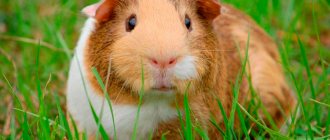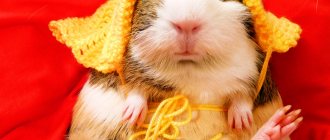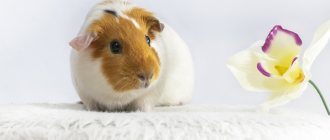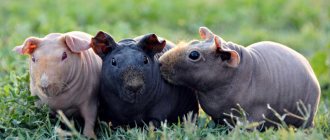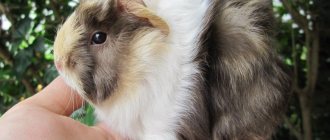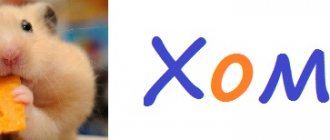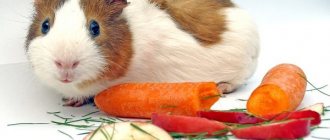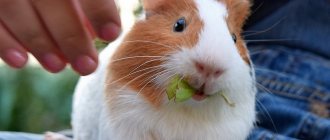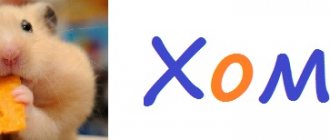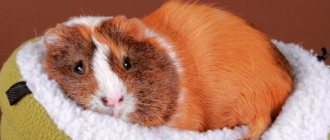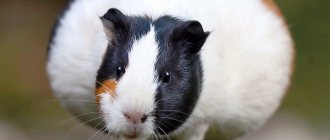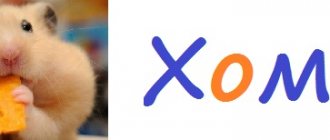- home
- Guinea pig
- Guinea pig breeding
02/14/2019 Any owner must have an idea of how much a guinea pig weighs. This directly correlates with the health and well-being of the animal. If you periodically find out the weight of your pet, you can find out whether the pig is developing correctly and notice if the indicators deviate from the norm. The data will help determine how well the brood is developing.
How to find out the age of a guinea pig
Before purchasing the animal you like, you need to find out the age of the future pet.
When it is purchased from a serious nursery, documents are attached indicating the exact date of birth. This rule applies more to rare, expensive breeds. In other cases, you can figure out on your own whether the animal is young or old, without relying on the integrity and competence of the sellers.
Behavior
The following features predominate in an animal up to one year old:
- activity and desire to explore everything around;
- tries new food with interest;
- interacts with people with curiosity;
- looks at other pets with interest;
- spends most of his time in active movement.
When the rodent turns 5 years old, activity begins to decline. By this time, taste preferences have already been formed, so pigs perceive new food with distrust.
Skin and coat condition
The fur and skin of an animal that has been well cared for for five years will look better than that of an unkempt one-year-old. Therefore, it is difficult to focus on this criterion. If a rodent has bald spots, matted fur, or spots on its skin, then the likelihood that it is no longer young is high. In order for these external characteristics to be in order, the animal must be well fed and the cage must be kept clean.
Identification by claws and teeth
The claws on the front paws are rarely in poor condition, since the rodent can take care of them on its own. The claws on the hind legs are an indicator of how the owner looked after the animal. If the claws are sharpened and have a yellowish tint, it means the animal is not young.
Young rodents' teeth will be white and sharp. They easily chew hard food. The older he gets, the darker the plaque on his teeth and the more difficult it is for him to eat solid food. Individuals approaching 7–8 years of age try to choose smaller and softer pieces.
Weight and height chart
The height and weight of a rodent matter when it comes to age. Guinea pigs grow up to the age of one and a half years and gain weight characteristic of this time period of life. You can follow this process using the table below:
| Age | Weight | Body length |
| 50–90 gr. | 8–10 cm. | |
| 14 days | 100–180 gr. | 10–12 cm. |
| 3 weeks | 200–250 gr. | 14–15 cm. |
| 5 weeks | 350–400 gr. | 16–20 cm. |
| 7 weeks | 500–700 gr. | 21–23 cm. |
| 12 months | 0.8-0.9 kg. | 25 cm. |
| 1 year 3 months | 0.9-1.2 kg. | 26–35 cm. |
End of growth in different breeds
Each breed completes growth and development differently, it all depends on growth, characteristics, habitat, nutrition:
- a yard dog, or as it is jokingly called a yard terrier. Due to the mixing of breeds, it is difficult to determine when such a dog will finish growing and what size it will reach. How long it will grow can be determined by external signs: if a large breed predominates, then the pet will grow large. Another factor is the size of the baby’s paws: the more massive the baby’s paws are, the larger he will grow and vice versa. If the mongrel is large, then it will grow up to 12 months, small - up to 8 months;
- the German Shepherd stops growing at 1 year;
- the Yorkshire Terrier can grow in 6 months and then only gains muscle mass;
- Pomeranian Spitz grows up to 6 months, after which bones become stronger;
- Great Dane grows up to 1.5 years and then gains weight up to 3 years;
- The mini toy terrier grows faster than all other breeds; by 4 months it becomes fully mature;
- The Chihuahua grows up to 8 months, then the skeleton only gets stronger;
- in a Labrador, growth ends at 1.5 years; at 2.5 years, the bones and muscles are finally formed;
- the husky completes development by 10 months;
- a boxer will mature by 1 year;
- the spaniel grows until about 8 months, then we gain muscle mass until 1.5 years;
- Beagles stop growing at 8 months.
Piglet weight table
The weight of piglets at birth, as well as in the first weeks of life, is determined on portable scales. Further determination is carried out in an evaluative way according to growth change tables.
However, upon reaching a weight of 25-30 kg, it is necessary to separate individuals for herd repair and fattening. The feeding schedule for gilts will be different. This is where measurements come in handy.
By week
The approximate weight of piglets by week of rearing is shown in the table:
Therefore, measurements should be carried out at the 9-10th week of the piglet’s life.
By month
After placement for fattening or raising replacement young stock, selective monitoring of the live weight of gilts is recommended to be carried out monthly.
Visually select at least 5 medium-sized individuals from each cell, take measurements and compare with the approximate growth plan presented in the table:
| Age, months | Live weight, kg |
| 3 | 39 |
| 4 | 45 |
| 5 | 65 |
| 6 | 85 |
| 7 | 110 |
Selling for meat is carried out upon reaching a live weight of 90-110 kg. Further fattening is impractical, since growth occurs due to lard, the market value of which is lower than meat.
At 8-12 months the pig will weigh from 120 to 180 kg.
It will be easy for a farmer to determine how much a newborn piglet weighs using a vag: the baby is placed in a special bag and its weight is measured.
A healthy baby that a sow has just given birth to weighs on average 0.8-1 kg; Vietnamese piglets barely reach 0.5 kg. There are also breeds that can give birth to a baby weighing more than 1.5 kg.
Age and weight of guinea pigs
A guinea pig's weight doubling occurs approximately 13 to 17 days after birth. At four to eight weeks of age, they weigh 250–400 g.
Guinea pigs grow up to 15 months. Their growth is gradually slowing down. Then males begin to weigh 1000-1800 g, females from 700 to 1000 g. The greater weight in some cases is due to significant fat deposits.
Guinea pigs live from five to eight years, in rare cases - up to 15.
Aging guinea pigs often lose weight. They are no longer able to optimally absorb the food offered to them. Then, along with a sufficient amount of hay and green food, it is recommended to increase the diet of nutritious foods such as carrots, concentrates and additional multivitamins
In addition, you should pay attention to the sufficient supply of the body with minerals and trace elements.
But special importance should be given to a sufficient supply of vitamin C to the body, which must be given at least 30 mg per kilogram of animal weight. Old guinea pigs, who may have dental problems, are less likely to turn to solid food and often enjoy eating sliced cucumbers or melons.
Fur that has lost its shine, and in some places even thin fur, also indicates the age of the animal. At the same time, older guinea pigs, often already with a weakened general resistance of the body, are very susceptible to skin diseases. Then fungi, as well as lice eaters and other ectoparasites appear in them much more often than among guinea pigs that are not yet listed as pensioners.
A guinea pig from about six years old, rarely from seven years old, is considered an “old lady”.
Features of feeding
It is known that guinea pigs are domesticated rodents that feed on dry grass. The basis of their diet is hay. In addition, animals eat grain feed:
- oats;
- corn;
- barley;
- wheat;
- sunflower seeds.
It is beneficial for animals to eat vegetables and fruits, as well as fresh herbs. These are valuable sources of vitamins and microelements. In winter, rodents are given grass pellets or grain sprouts. The diet must include branches of fruit trees.
Guinea pigs should not be offered food of animal origin, as well as potatoes, red beets, and citrus fruits. Confectionery and bakery products are strictly prohibited.
Weight and size of guinea pigs by month
Any owner must have an idea of how much a guinea pig weighs. This directly correlates with the health and well-being of the animal. If you periodically find out the weight of your pet, you can find out whether the pig is developing correctly and notice if the indicators deviate from the norm. The data will help determine how well the brood is developing.
Factors affecting the height and weight of an adult
The modern guinea pig has generally accepted standards, but its weight and size fluctuate due to a number of reasons.
Newborn pigs
Typically, at birth, the length of a baby pet is about 10 cm
. However, you need to take into account the number of piglets in the litter; the more cubs, the less growth. Length is influenced by priority; as a rule, large piglets are born first. An important factor is the well-being of the female during pregnancy.
In a couple of months after birth, a piglet can almost double in size, up to 15-20 cm. Then growth will slow down a little, but by six months the baby will stretch to 20-25 cm.
When it reaches one and a half years, the animal grows to 20-30 cm
. These parameters are final; the rodent is considered an adult.
A big factor influencing the size of an individual is gender. As with all animals, the male is larger and heavier than the female.
Breed
An important factor is the breed of the animal. The sizes of animals crossed during the selection process can be either miniature or quite large.
. Having large volumes, animals of the following breeds can boast from a kilogram:
- Coronet
- Peruvian
- Abyssinian
- Himalayan
- Ridgeback
Unfortunately, due to the great interest in rodents, the number of people who breed animals has increased. This has led to a slightly lower standard than that of rodents living in the wild.
Nutrition
Balanced nutrition and nutrition from the first days of life play a vital role in determining the weight and size, as well as the health of the pet. Fresh dried hay, fruits and vegetables rich in vitamins, twigs of bushes and root vegetables should be in the public domain. However, it is worth remembering that overfeeding is unacceptable.
which will lead to obesity.
Newborns
It is also interesting to know what size a guinea pig should be at birth. The cubs that are born have a height of 5 to 10 cm. In small breeds, the weight usually does not exceed 45–50 g, and in large breeds it reaches 100–120 g.
Much depends on the number of newborns in the litter. The more cubs a female bears, the smaller the size of each of them. Birth order also plays a role. Individuals born first are usually larger than others.
The size of the babies is also affected by the course of pregnancy in the female. If the guinea pig is healthy, then it can bear three large cubs, which at birth will weigh at least 100-120 g.
Cubs are considered newborns under 7 days of age. During this period they practically do not grow.
When does growth stop?
At the age of 1.5 years, a guinea pig stops growing. The animal is considered an adult and reaches its maximum size. If the pet is older than 15 months, then you can no longer expect an increase in growth.
With proper nutrition, adult pigs do not experience significant fluctuations in body weight. Normally, the weight of a male is from 1 to 1.8 kg, and that of a female is from 0.7 to 1 kg. If your pet's body weight exceeds these indicators, then the diet should be urgently reviewed. Obesity is very dangerous for these mobile and active animals.
At the age of 4 years, the pig begins to age. The animal's reproductive function gradually fades, previous activity disappears, and metabolism changes. In old age, animals often lose weight. This is a natural phenomenon
However, if you lose too much weight, you should pay attention to the health of the animal.
With good care, the life expectancy of animals at home is from 6 to 8 years. Short-haired rodents generally live longer than long-haired and hairless (hypoallergenic) breeds.
The size of an adult guinea pig largely depends on its conditions during childhood. The main role here is played by the animal’s diet. After all, the pet gets the substances necessary for growth from food.
In order for your pig to reach its maximum size, you must adhere to the following care recommendations:
- At the age of up to 20 days, the cubs feed on mother's milk. The period of breastfeeding should not be artificially shortened. Babies separated from their mother early develop and grow worse.
- A nursing guinea pig should be regularly given full-fat cow's or goat's milk, as well as cream. This is especially necessary with multiple litters. Such nutrition will improve the production and quality of milk, and in the future will ensure good growth of the cubs.
- The diet of growing guinea pigs should regularly include vegetables and fruits, as well as dry hay. Root vegetables and branches of bushes should always be in the cage. Such food will enrich the cubs’ body with useful substances necessary for growth.
- It is useful to give young guinea pigs special supplements with vitamin C. This microelement is practically not produced in their body. Deficiency of ascorbic acid leads to slow growth of animals.
It is very important to ensure that the animal does not overeat. After all, guinea pigs are quite gluttonous.
From the age of six months, the pet must be periodically released from the cage. Walking around the house and playing outdoor games will help prevent excessive weight gain.
Periods of growing up
Conventionally, the life of a pig can be divided into 4 stages. The norms for weight and size may differ for different breeds, but for the dynamics of development they are common to all representatives of the species.
- childhood - 0-3 months;
- youth - 3 months - 1.5 years;
- maturity - 1.5 - 5.5 years;
- old age from 6 years.
The childhood period is characterized by intensive growth. The average weight of a newborn cavia is 50-140 g. The parameters are influenced by the age of the mother, living conditions during pregnancy, and the number of cubs in the litter. Usually the larger animals are those that were born first in the litter.
Baby guinea pigs are born quite large with fur and already with open eyes
How much a particular pig should weigh at 2 weeks can be determined by doubling its weight on the first day.
By the fifth week, the guinea pig's growth reaches 19 centimeters. Age is good for purchasing a pet. By this time, the animals are completely ready to be weaned from their mother.
Girls reach puberty around the 30th day of life, boys around the 70th day. Animals show interest in individuals of the opposite sex and are physically capable of reproducing. The rodent's body is still not fully formed, so mating at such an early age is not recommended.
In adolescence, the animal begins to show interest in the opposite sex. At 3 months, the difference in size between rodents of different sexes becomes clearly pronounced. The weight can exceed that of a newborn piglet by 10 times.
The formation of the body ends by the 6th month. The animal is ready to perform its reproductive function. The growth rate is decreasing.
The rodent becomes an adult at 15 months. Until these years are reached, kavias grow and gain mass. An adult guinea pig should weigh at least 700 g.
The average life expectancy of a pig is 6-8 years. From the age of 4, age-related changes begin in the body. By the age of 6, your guinea pig may begin to lose weight. Reproductive function is disrupted, problems with the absorption of nutrients appear. Aging affects appearance, coat and mobility.
Guinea pig age - to what age do guinea pigs grow?
How to find out the age of a guinea pig: periods from birth to old age
The physiological development of guinea pigs can be divided into the following periods of their life:
I. Milk feeding (from 1 to 21 days).
II. Immature period (25-50 days ... 51-150 days).
III. Reproductive period (6-18 ... 35-40 months).
IV. The period of senile changes (3.5-5 ... 6-8 years).
At what age should you buy a guinea pig?
Guinea pigs under 4 weeks of age are vulnerable and are more susceptible to various diseases. Therefore, it is best to buy an animal aged 4 weeks or older.
How to determine the age of a guinea pig
The easiest way is to weigh the animal. Guinea pigs are usually sold to pet stores at 3-4 weeks of age. The weight of animals at this time usually fluctuates between 400-500 grams. Moreover, it does not matter how the animal eats. Even animals with a good appetite will not weigh more at this age. An adult, sexually mature animal at 15 months weighs 700-1000 g (females) and 1000-1800 g (males).
Caring for an elderly animal
From 3-4 years old, guinea pigs begin to age. It is better not to allow such animals to reproduce.
Because older pigs often lose weight, they require increased attention to nutrition. You should definitely include more vitamins and microelements in your diet.
The feed itself should be more concentrated than for young animals.
Often, inflammation and even ulcers appear on the pads of guinea pigs as they age. Such places must be washed with antiseptic agents. A weak solution of potassium permanganate will do. After the procedure, the rodent’s paws are dried and treated with streptocide powder. The animal must not walk for 20 minutes. As long as the affected areas are visible on the paws, they need to be lubricated daily with BF-6 medical glue.
The size of an adult guinea pig largely depends on its conditions during childhood. The main role here is played by the animal’s diet. After all, the pet gets the substances necessary for growth from food.
In order for your pig to reach its maximum size, you must adhere to the following care recommendations:
- At the age of up to 20 days, the cubs feed on mother's milk. The period of breastfeeding should not be artificially shortened. Babies separated from their mother early develop and grow worse.
- A nursing guinea pig should be regularly given full-fat cow's or goat's milk, as well as cream. This is especially necessary with multiple litters. Such nutrition will improve the production and quality of milk, and in the future will ensure good growth of the cubs.
- The diet of growing guinea pigs should regularly include vegetables and fruits, as well as dry hay. Root vegetables and branches of bushes should always be in the cage. Such food will enrich the cubs’ body with useful substances necessary for growth.
- It is useful to give young guinea pigs special supplements with vitamin C. This microelement is practically not produced in their body. Deficiency of ascorbic acid leads to slow growth of animals.
It is very important to ensure that the animal does not overeat. After all, guinea pigs are quite gluttonous.
From the age of six months, the pet must be periodically released from the cage. Walking around the house and playing outdoor games will help prevent excessive weight gain.
Necessary for care
Like any other pet, a guinea pig requires a wide variety of grooming accessories. These include:
- cage or aquarium;
- feeder;
- sippy cup;
- house;
- filler;
- mineral stone;
- toys;
- carrying;
- hygiene products;
- brush-comb and nail clipper.
Cage or aquarium
Keeping a guinea pig is allowed both in an aquarium and in a cage. The main condition is size: the dwelling must be at least 50 cm in length and 30 cm in height so that the animal can move comfortably. If you have decided on a cage, then it is best to take a closer look at the options that have a plastic bottom. Plastic is quite easy to care for, it is easy to wash, dry, etc. A wooden base is not suitable due to the fact that these animals drink a lot of liquid per day, and therefore excrete a large amount of urine. The wood will simply become unusable in a very short time. You can purchase an aquarium in the above sizes. It, like a cage with a plastic bottom, is easy to wash and clean. But you should be careful, since glass is a very fragile material and when moving it, for example, to another room, you should follow safety rules (the pet should not be in the aquarium, it should be transferred to a carrier).
cell
Feeder
The feeder should be heavy enough so that the guinea pig cannot knock it over. An excellent option would be bowls made of ceramics, stainless steel, etc. It is also recommended to buy 2-3 containers. For example, one will be used for vegetables or fruits, and the second for dry food.
Sippy cup
A vertical ball sippy cup is perfect for a guinea pig. It is usually made of plastic with a metal tip. In such a drinking bowl there is no need to change the water daily, but this is done about 2-3 times a week.
House
Be sure to install a small house in the cage or aquarium. Your pet will sleep in it, relax, or simply retire when he wants to be alone. Most often, such houses are made of wood with a round “door” cut out in the middle. The most optimal size is 25 cm in length and 15 cm in height. This space is enough for the animal to hide and at the same time feel comfortable.
house
Filler
When arranging the cage, do not forget about the bedding. It will create comfort in the cage, prevent the animal from freezing and, to some extent, maintain cleanliness. You can use sawdust or ground corn cobs as a filler. Under no circumstances put cotton wool, newspaper, paper, etc. in the cage as bedding, as this is not safe for your pet’s health.
Mineral stone
To maintain dental health and calcium levels in your guinea pig's body, mineral stone is essential. After all, it serves not only as a vitamin complex, but also perfectly helps the animal grind its teeth. This stone is sold in a pet store, and its price is quite affordable.
stone
Toys
Guinea pigs are somewhat similar in behavior to decorative rabbits. They love to play. Therefore, be sure to buy some interesting and funny toy for your pet, for example, a tunnel, a hammock, a mirror, a rolling wheel, etc. The game will not only bring joy and pleasure to the animal, but will also strengthen muscles, and will also be an excellent preventive measure against obesity.
Carrying
If your plans did not include traveling together or any trips with your guinea pig, then you will still need a carrier. Transporting an animal in your arms, in a box or blanket is strictly prohibited. For example, you need to visit a veterinarian or transport the animal to another house or apartment; in such life situations, a carrier will definitely help you out. The pig will feel safe and the transportation process will go smoothly.
Hygiene products
Guinea pigs are considered clean animals, but sometimes they are still allowed to be bathed. For such cases, it is necessary to use special hygiene products that can be purchased at a pet store. The most popular of them:
- "Biogance" - bio-perfume;
- "Veda" - wheat shampoo.
Brush-comb and nail clipper
Caring for your guinea pig's coat and claws is extremely important. To do this, you need to purchase a special comb with soft bristles (combing is done daily), as well as a nail clipper for trimming the claws (the procedure is performed as they lengthen).
Description of the breed
Abyssinian pigs are characterized by the formation of a rosette-shaped pattern of hair, when the hairs radiate from the center to the periphery. Where one circle meets the other, the hair stands up, giving the pig a disheveled and incredibly cute look.
According to the standard, there should be from eight to ten sockets. In some cases, twelve are allowed. Their arrangement is not chaotic, but symmetrical; the ridges (joints) form something like a chessboard, and the distance between the “cells” should be the same.
Thus, ideal rodents are those that have:
- two rosettes on the back of the nose,
- two in the forearm area,
- four on the back
- two on the sacrum and hind legs.
The following characteristics are characteristic of this type of domestic animal:
- a large, wide head is framed by sideburns and has a pronounced “mustache”;
- mane sticking up,
- bulging and bright eyes,
- narrow nose,
- The ears are medium-sized, widely spaced and slightly drooping down,
- The body is compact, muscular, shoulders are broad.
The thick coat is as tough as it gets. Its length should not exceed 3.5-4 cm. Usually, females have softer hairs. The protruding ridges of the rosettes are well defined, stand parallel to the body, and the cup-shaped curls themselves have clear boundaries and do not merge with each other.
By the way, you should not evaluate the growth pattern and shape of rosettes in pigs until they are 20 weeks old. At an earlier age, the ridges may not be clearly expressed, lie close to the body, and the animal is mistakenly discarded.
A mutation often occurs when the entire guinea pig is covered with double rosettes, the number of which can reach up to 30 pieces. Naturally, such rodents are discarded. Smooth-haired pets with flat sides and weak or curled combs are also disqualified.
Record copies
Among the popular breeds of rodents there are real record holders in length and weight category. Let's find out how big a guinea pig of popular breeds grows to.
- The tortoiseshell with white "Cake" is a relatively young breed bred by English breeders. The “cakes” crossed inside the breed delight the eye with their bright colors and impressive dimensions.
Article on the topic: Roborovsky hamster: description, care and maintenance, distinctive features
The average length of the body reaches 35 cm, and weight up to 1.6 kg . At the same time, the rodent is very active and inquisitive.
- A large guinea pig is the English Rex, the ancestor of many varieties. And to match the name of the breed, it is truly royal in size. At a young age, the development of cubs differs from the basic parameters, and the piglet’s maturation ends closer to two years. By maturity the animal grows up to 45 cm.
- Kui is the absolute champion among the guinea pig species . Small kui at birth weigh about 200 grams, and the weight of an adult pet reaches 4 kilograms, with a body length of 50 cm. Despite their gigantic size, these rodents are more susceptible to stress than others and are not very talkative.
Character of the Abyssinians
It has already been written above that all representatives of the breed are characterized by pugnacity and quarrelsomeness. True, this only applies to those cases when the owners are trying to add new individuals to an already established social group.
The fact is that in the “family” there is a strict hierarchy, where there is a boss (usually a male) and subordinates (females). If you introduce a new member, then a struggle for leadership will naturally begin, which will inevitably lead to fights and a showdown. Both males and females can fight, and the latter fight just as desperately as the stronger sex.
In some cases, it is the males who act as peacemakers, reconciling careless, jealous females among themselves. “Girls” can hate each other, but at the same time behave more or less peacefully, as long as the situation is under the control of the leader.
Therefore, when forming families, you must follow simple rules:
- create families from an early age,
- in any group there should be several females and one male who will regulate relationships,
- never place pregnant females into an established group, otherwise the loss of offspring cannot be avoided,
- To keep several pigs, choose the largest cage possible so that the pets have their own space.
Despite the complexity of relationships between relatives, rosette pigs behave more than ideally with humans. They respect and love the owner as their breadwinner. They are always kind and peaceful with him. There has probably not been a single case of a rodent biting a person at least once.
Moreover, patterned pets not only coexist with people, but are excellent companions and happily communicate with the owner, greeting him with joyful purrs and squeaks.
Breeding
It has already been noted that rosette rodents are the most difficult pets in matters of reproduction. But this does not concern fertility, but is associated with the difficulty of obtaining offspring of the required standard.
Very often, smooth-haired babies are born, which in principle is the norm. But the appearance of cubs with irregular rosettes indicates a non-sterile gene pool, in which the blood of some other breeds is present.
Important! Cannot be crossed with long-haired breeds. Perhaps the first generation will be rosette with a perfect “chessboard”, but the second and subsequent litter will turn out to be terrible with incomprehensible-looking rosettes located in a chaotic order
In addition, long-haired pigs will make the coat silky and overly soft.
Rosette guinea pigs are beautiful in their own way with their ruffles and patterns. They are distinguished by good health, easy to care for and not demanding in maintenance, so they are often considered ideal pets for children and beginners.
Owner reviews
Of course, the cost of a purebred rare pig is not always affordable for the average buyer, but if you want to engage in professional breeding of such popular rodents, your choice should be on animals with an excellent pedigree.
This is interesting! Pig breeding in our country has not yet reached foreign heights, but already now connoisseurs of decorative rodents are striving to acquire pets with an original and exotic appearance.
Experienced owners are categorically against crossing representatives of long-haired and short-haired breeds, since all the resulting offspring will be classified as low-quality mestizos that do not take part in exhibition shows. Among other things, the inadmissibility of mating representatives of heterogeneous breeds is due to the inhibition of the development of breed qualities.
In any case, the guinea pig is rightfully one of the best pets, especially for anyone who is trying to get an animal for the first time. This animal is unpretentious in care and easy to keep, very affectionate and quite sociable, so it is ideal for home keeping even in families with children.
Return to content
How to find out the age of a guinea pig
If the choice fell on an adult animal, then try to determine the age of the guinea pig at home yourself.
Focus on the following features of the rodent:
Behavior and physical activity
The main characteristics of a young individual:
- the animal is interested in everything that happens around it;
- tries new foods with appetite;
- ready to communicate with household members;
- runs and plays a lot.
At an older age, animals are not so active: they sleep a lot and often and look apathetic. Older pigs often stop gnawing large pieces of food.
Weight and height
The height of an adult is, on average, 27-30 cm. The weight of a baby up to 4 weeks does not exceed 0.5 kg. The period of maturity begins at 15 months. The weight of an adult female varies from 0.7 to 1 kg, and an adult male - from 1 to 1.8 kg. How to determine the sex of an animal, read our article “Determining the sex of a guinea pig: distinguishing females from males by external characteristics”
Skin and coat condition
In young pigs, unlike older ones, the skin is clean, without signs of peeling or scratching, and elastic. Their coat is thick, rich in color, shiny, and without signs of shedding. It should be taken into account that the quality of the coat depends both on age and on the presence of diseases or parasites (fleas, ticks).
Condition of claws and teeth
Carefully examine the claws on the hind legs - they are more difficult for your pig to care for than the claws on the front legs. Typically, pet stores do not have the habit of caring for pigs’ claws, sharpening or trimming them in a timely manner. Therefore, an animal's nails can tell a lot about its age. Thus, at the sight of long or heavily sharpened, curved and yellowed claws on the paws, one can conclude that their owner is mature. The young individual's teeth are white, sharp and strong, and she happily gnaws on solid food. An elderly pig has worn-down teeth, often with a dark coating, and tries to chew small pieces of food.
When choosing a funny rodent, do not forget to ask the seller about its age, eating habits and preferences. Examine the animal for obvious diseases, evaluate its appearance: the condition of the fur and skin, claws and teeth.
Take a closer look at the characteristic behavior of the rodent in the cage. If, after purchasing an animal, you have any doubts about the exact age or health status of the rodent, consult a veterinarian and ask for detailed recommendations on the care and preparation of the correct diet for your pet.
Longevity Factors
The lifespan of guinea pigs at home depends on care and nutrition. But owners should remember that pets at any age need communication and attention. Loneliness leads to prolonged stress and shortens the animal’s life.
Conditions of detention
Guinea pigs love to eat tasty and satisfying meals and lie down on soft bedding. The owners will have to stimulate the animals’ physical activity:
- choose a spacious cage or build an aviary;
- arrange a play area (tunnels, balls with bells);
- organize a walk around the apartment.
There should be no drafts in the room where the pet lives. The air temperature should be maintained at 18–22ºC; for hairless pigs, a comfortable temperature is 22–24 ºC.
Care
Maintaining good hygiene extends the life of guinea pigs. Once a week you should examine your pet's ears and eyes. If the baby cannot clean them himself, then he is gently helped. The fur coat of a guinea pig, especially a long-haired one, is combed out with a special comb.
The animals are bathed as their fur gets dirty. Pets of any age love to soak in warm water. Bath procedures are carried out indoors without drafts. After the bath, the guinea pig is wrapped in a towel to absorb excess moisture. The fur is finally dried using a warm stream of air from a hairdryer.
Guinea pigs cannot take care of their claws on their own. Long claws curl into a spiral, interfere with the pet's movement and can lead to deformation of the fingers. The excess is trimmed with nail clippers, which are sold in pet stores.
Proper nutrition
Rodents cannot go long without food. Digested foods are not removed from the intestines until a new portion of food enters it. Pieces of food are constantly pushing each other through the digestive tract.
But you shouldn’t go to the other extreme and overfeed your pet. The amount of food should correspond to the following proportions:
- grain feed – 60%;
- dry hay – 20%;
- juicy vegetables, fruits, herbs – 20%.
The body of guinea pigs is not able to synthesize vitamin C. Owners will have to use vitamin supplements. It is convenient to add a few drops of ascorbic acid to drinking water.
Heredity
Proper care and diet will not be able to increase the lifespan of an animal if the genetic code is broken. Babies born from old or sick individuals live a short life.
When purchasing a pig, it is almost impossible to visually determine the presence of the disease. You can protect yourself from surprises in a pet store, where babies are supplied by experienced breeders. They present a document containing information about the parents.
Health control
The immune system of rodents is capable of coping with many problems, but it can also fail. The following symptoms should be a warning sign for owners:
- cough, sneezing;
- lethargy, drowsiness;
- hair loss;
- refusal of food.
Early contact with a veterinarian increases your pet's chances of recovery. The specialist will not only prescribe medications, but will also help organize the space in which the guinea pig lives.
Breed influence
Breeders have bred fifty varieties of guinea pigs. But the lifespan of ornamental animals, compared to their wild counterparts, has been significantly reduced:
- Short-haired breeds live the longest. The average life expectancy is 8 years.
- With proper care, long-haired pigs can live up to 7 years.
- Hairless animals are most susceptible to diseases, so they manage to live for about 5 years.
Average weight of a pig at different ages
The livestock breeder should decide which breed of pigs he will breed. Modern breeds are characterized by the fineness of their bacon.
In the conditions of livestock complexes, they reach a slaughter weight of 100 kg in 23-24 weeks. You won't get lard from them.
Fatty breeds are characterized by low growth rates and high feed costs for growth.
It is unpretentious, tolerates unfavorable conditions well and is characterized by stable productivity. Suitable for the production of meat and lard.
In order to combine the quality and yield of products with profitability, they focus on the average daily gain of fattened pigs - 650-700 g.
The table shows the average weight of animals of different ages:
If a livestock breeder plans to raise a queen, he must take into account that at the age of seven months the replacement pig reaches sexual maturity.
There is a rough estimate of a sow's weight by age. It is believed that after each farrowing, the female gains 25 kg.
So, if at the first mating the weight of a pig of average fatness was 115 kg, then by the time of the second insemination it is 140, the third - 165 kg, etc.
How to measure the weight of an adult pig?
Adults should be considered pigs that have completed their growth, that is, animals older than 9 months.
The following methods have been developed for measuring live weight without weighing:
- Measurement according to the table.
- Calculation using formula.
- Calculation by fatness category.
Measuring by table
To calculate the live weight of a pig, use a measuring tape. It is most convenient to use a one and a half meter tailor's tape. The procedure is carried out in the morning, on an empty stomach.
Make sure the animal stands upright. To do this, the assistant offers her a treat from his hand. First, determine the length of the body. The tape is applied to the back of the head and pulled to the base of the tail.
The second measurement is the circumference behind the shoulder blades.
The next stage is determining the weight using the table. The mass of the animal is determined at the intersection of rows and columns.
If the body length is 102 cm, and the chest circumference behind the shoulder blades is 120 cm, the pig’s weight is 123 kg. The error in determining mass varies within ±10%.
Calculation by formula
There is a special formula:
B=0.99*D+1.54*O-150;
where: B is the weight of the animal, D is the length of the body, O is the girth behind the shoulder blades.
The result of the calculation is 133 kg. Tabular and calculated results vary widely. Table data was developed by comparing measurements with weighing results. Therefore, it is better to use them rather than formulas.
Calculation by fatness category
A formula has been developed for calculating live weight as the product of body length and chest girth divided by a coefficient, which for pigs of average fatness is 156.
The result is a greatly underestimated result, in our example 79 kg. Therefore, it is better to use the weight determination according to the table.
Determining body condition is of practical importance for correcting the diet of pregnant sows.
The figure shows the appearance of pigs with different fatness categories:
Academician V. G. Ryadchikov gives the following criteria for assessing the fatness of sows:
In order to even out the condition, from 5 to 36 days after mating, skinny animals are fed 4 kg of compound feed daily, fat animals - 2 kg.
At what age is it best to adopt a guinea pig?
Guinea pigs, depending on the breed, genetic predisposition and proper care, can live 8-10 years. There are isolated cases when they reached a record 15 years. At about five years old, the animal’s body begins to age. Sometimes the process goes very quickly and the animal can suddenly die from various age-related pathologies even at 6 years old. This must be taken into account when purchasing an animal.
There is another reason why you should not take a rodent older than one year. It will be difficult for her to get used to new hands. Changing your place of residence will cause stress and shorten your already short life.
It’s great if the pet is adopted into a new family at 5 weeks. Until this moment, the animals must be with their mother. It is better to adopt an animal at a more conscious age. It is not advisable to take an animal that is already more than a year old.
The breeder or store seller must accurately inform how many months or years old the animal is. If there is no clear answer, or there are doubts, it is better to look for the animal elsewhere and not take risks. When you really like the pig, you can try to find out the age of the animal yourself.
Controlling your pet's weight
When breeding guinea pigs, they are regularly weighed to ensure the animals are developing normally. It doesn’t hurt to navigate the parameters even when the rodent has reached adulthood. Every week you need to weigh your pet in order to notice deviations in its development in time.
If your guinea pig begins to lose weight, then you need to reconsider its diet. Most likely, the animal lacks nutrients. Many diseases are characterized by sudden weight loss. Many can manifest themselves outwardly only in this way. In any case, the pet requires qualified help.
Weight control does not require special equipment. Floor scales are also suitable for accurate indicators, but it is much more convenient to perform the procedure using kitchen equipment. Guinea pigs react absolutely calmly to the procedure.
To get accurate results, you need to immobilize the animal. You can try giving your guinea pig a tasty treat or coaxing it with affection.
Sequence of weighing a rodent:
- The pet is placed in a container for convenience;
- The container is sent to the scales, the mass is recorded;
- You need to get the pig and weigh the empty plate;
- You need to subtract the weight of the plate.
It is recommended to keep a record of all parameters in a separate notebook. It is important not only to record measurement data, but also the dates of control weighings. If the animal gets sick, a notebook with such information will be very useful for the veterinarian.
Purchasing a guinea pig requires special responsibility. It is important to remember that we are responsible for those we have tamed. This furball is completely dependent on its owner. That is why it is necessary to properly organize the care of your pet. If you follow all the rules, your guinea pig will live up to 10 years.
What I am a master at is talking incessantly about hamsters. I have three hamsters at home, and my husband has a pet rat. That’s how we live, the six of us eat, the six of us sleep :)
When does growth stop?
At the age of 1.5 years, a guinea pig stops growing. The animal is considered an adult and reaches its maximum size. If the pet is older than 15 months, then you can no longer expect an increase in growth.
With proper nutrition, adult pigs do not experience significant fluctuations in body weight. Normally, the weight of a male is from 1 to 1.8 kg, and that of a female is from 0.7 to 1 kg. If your pet's body weight exceeds these indicators, then the diet should be urgently reviewed. Obesity is very dangerous for these mobile and active animals.
At the age of 4 years, the pig begins to age. The animal's reproductive function gradually fades, previous activity disappears, and metabolism changes. In old age, animals often lose weight. This is a natural phenomenon
However, if you lose too much weight, you should pay attention to the health of the animal.
With good care, the life expectancy of animals at home is from 6 to 8 years. Short-haired rodents generally live longer than long-haired and hairless (hypoallergenic) breeds.
Stages of life according to human standards
The lifespan of most pets is comparatively shorter than that of a human, so their owners have a completely logical question: how to compare age stages. Considering that most rodents at home do not live more than 8 or 10 years, and also focusing on their condition during this period of time, the ratio of their age to a human will look something like this:
| Person's age | Guinea pig age |
| 6 months | 15 days |
| 12 years | 4 months |
| 23 years old | 15 months |
| 65 years old | 6 years |
| 85 years old | 8 years |
Just like among people, among guinea pigs there are real long-livers, so if a rodent has been living with you for about 15 years, it can be argued that if it were a person, it would have long ago crossed the hundred-year mark of its life.
Average weight of a pig at slaughter
Before taking an animal to slaughter, farmers fatten it until it reaches the desired weight. Typically, individuals weighing from 100 to 150 kg are slaughtered for meat. The most effective yield after slaughter will be for a pig with a live weight of 180-200 kg.
Indicators after slaughter will differ from live weight.
So, depending on the initial data, the output will be:
- 100 kg - 75%;
- 130-150 kg - 80%;
- from 175 kg - 85%.
Half carcasses, carcasses and quarter carcasses
A boar carcass is pure meat that remains after the remaining organs and parts have been removed. For example, after slaughter, a live weight of 100 kg will yield 73-75 kg of carcass.
There are different cutting methods: English, German, American, Moscow.
It is generally accepted to divide the carcass into half carcasses. They, in turn, are divided into halves, resulting in a quarter of the carcass. So, the hind quarter will include the hind leg, the front part consists of the fore limb.
Weight of other organs
To obtain a carcass, the remaining organs are removed from the body of a slaughtered animal.
Their approximate mass is indicated in the table:
| Bones | 10-12 kg |
| Heart | 300-350 g |
| Head | 8-10 kg |
| Lungs | 800-850 g |
| Liver | 1.5-1.7 kg |
| Kidneys | 250-270 g |
| Salo | 23-25 kg |
| Waste | 2.5-3.5 kg |
Figuring out how to measure the mass of a pig is quite simple. To do this, you need to use special formulas or tables
It is important to consider that they are only suitable for live individuals, and the number of kilograms after slaughter will be slightly less
When do they become sexually mature?
Guinea pigs are fast maturing animals. The ability to reproduce in young pigs occurs quite early.
Males can mate and produce offspring at the age of 2.5 - 3 months, and females come into heat starting from 35 - 45 days.
It is contraindicated to deliberately create pairs or allow rodents to be bred so early.
A young female, weighing less than 500 g, rarely produces strong, viable offspring. During the birth process, not only the offspring, but also the adult animal can die.
Physiologically, although a pig can mate, its body has not yet fully formed, and the birth canal is too narrow. A guinea pig can become pregnant without health risks at 5-6 months, and the male reaches optimal readiness for reproduction at 10-12. Starting at this age, pets can mate.
When deciding to breed their animals, the owner must be prepared for the fact that rodents for veterinarians are not the usual cats and dogs. They simply may not have enough skill and experience in managing childbirth in such relatively small animals.
To avoid early and unwanted matings, it is better to keep animals in same-sex groups. And a male should be placed with a female only for planned and thoughtful reproduction. If the couple is of breeding interest, then it is advisable to plan the first birth before the female reaches 12 months.
Taking into account the fact that pregnancy lasts up to 62 - 68 days, the best time for mating females begins from 6 - 8 months.
How to play with guinea pigs?
How big does a guinea pig grow?
A pet's weight is directly related to its age. But growth is no longer a property of a specific animal, but of an entire species. The pig systematically gains weight over the course of months, up to a year and a half.
An adult animal stops growing at 15 months. At this point, the average weight of the pet is about 2 kilograms. Females stop at 700–1200 grams, and males 1–1.8 kilograms. The length does not exceed 35 centimeters.
The weight of an adult pet is maintained at approximately the same level. If sudden changes are noticed in any parameter, then this is an alarming signal and you need to consult a specialist. If you regularly monitor weight and height parameters, you can identify some animal diseases in the early stages and begin their treatment in a timely manner.
Guinea pigs do not stop gaining weight until 15 months; if after this the pet is still gaining weight, then there is a chance that he is suffering from obesity. This difficulty occurs with a sedentary lifestyle and an unbalanced diet.
If your guinea pig does not gain weight or even loses it sharply, then it is likely that its diet does not contain enough essential elements. This is also how some types of diseases manifest themselves, for which weight loss is one of the visual symptoms. To understand the real reason, you need to fully examine your pet.
Natural size of a rodent
In nature, the appearance of wild pigs only vaguely resembles decorative domesticated rodents. Nimble, agile and with a strong muscular body, the animals have been looking for food for centuries and trying to hide from birds of prey and animals, and from people who have discovered the taste of a new type of meat.
Article on the topic: Ear drops for dogs: how to choose and use correctly for otitis media
Despite its light and graceful body structure, the wild pig is hardy and adapted to long runs in search of food . An oblong body with a short neck and legs seems designed to flow among stones and seek shelter in underground tunnels.
Despite the small size and graceful forms of the wild pig, there are real giants among its relatives:
- Moko is a rock pig. It is larger in size than a guinea pig and weighs up to 1 kilogram.
- Agouti - the body of the animal grows up to 50 cm, and weight up to 4 kg.
- Pack - body about 40 cm, weight 10 kg.
- Mara is a rodent belonging to the half-ungulate family. The length of the body reaches 70 centimeters, and the weight is up to 16 kg.
- Pacarana is an animal up to 80 cm long and weighing up to 15 kg.
- The capybara is the largest rodent. The length of the body is 1.3 meters, and the weight is 50 kg .
Since wild animals have been hunted since ancient times, in order to maintain the population, wild species of rodents were forced to interbreed, and there were no purebred pigs left among them. This is confirmed by the range in size of pets, from 15 to 30 cm. Selection has also borne fruit. The domesticated pig lost its tail, but acquired a pleasant rounded shape and relatively larger size than the wild specimen.
Weight and size of guinea pigs
The body structure of decorative cavy differs from its wild counterparts in the width and roundness of its shape. The normal weight of a guinea pig depends on gender and breed. Males are larger than females, by about 20-25%.
The limits to which guinea pigs grow are influenced by genetics and the conditions in which the animal grew up and is kept. Monitoring the dynamics of parameters and comparison with the norm helps to monitor the health of the pet.
What does the size of the animal indicate?
The following factors influence the size of a guinea pig:
Why does the owner need to know the normal size of the pet? First of all, height and weight indicate the health status of the animal. Knowing the normal dimensions of a pig also helps you navigate correctly when buying a pet. Based on this indicator, one can judge the estimated age and purity of the animal’s breed.
Next, we will take a closer look at the factors that influence the height and weight of guinea pigs.
How big does a male guinea pig grow? Adult males can reach a body length of up to 35 cm. They weigh up to 1.5 kg. Mature females are usually much smaller, their height is no more than 25 cm, and their weight rarely exceeds 1 kg.
